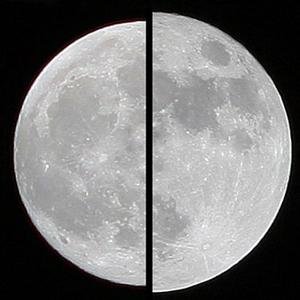Reached at the closest to the Earth while it will be full, the Moon is supposed to offer us the beautiful spectacle of an”extra-super Moon” on Monday, November 14. Really ?
November 14, 2016, the full moon will occur at a very special moment at the time when it will be closest to Earth in decades, producing a “super moon” record has never been seen since 1948, with an apparent diameter in the sky 14% more important than the “small” moons.
• Why a “super Moon”?
A super Moon is visible when the full moon, when our satellite appears to us to be fully illuminated by the Sun, occurs near the moment where the Moon is at the closest to the Earth. In reality, the name “super Moon”, which was invented by an astrologer u.s. in the 1970s, does not please really to the professional astronomers who prefer the term ” dedicated “perigee-syzygy” (perigee to the position of the orbit of the Moon nearest the Earth, and syzygy for the moment 3 celestial objects are aligned).
• Why the Moon will be closest to the Earth?
the Moon’s orbit is not perfectly circular, the distance which separates it from our planet therefore it is not always the same: it varies from 405.000 to 363.000 km. But these distances are just averages, and can vary greatly according to the Sun, whose enormous mass has a great influence on how the little couple formed by the Earth and the Moon. This Monday, November 14, at exactly 12h21 (Paris time), our planet and its satellite are going to be extremely close, with “only” 356.509 km according to calculations of the Institut de mécanique céleste et de calcul des éphémérides (IMCCE) of the Observatoire de Paris. Never been seen since January 26, 1948, when the Moon came full at 356.461 kilometers from the Earth. It will have to wait for the 25th of November 2034 to do better: 356.445 kilometers.
• The Moon seem-t-it is bigger?

right, the “spuer-moon” march 2011 view from the Earth compared to the moon “average” of December 2010. Photos Images by Marco Langbroek, the Netherlands, mounting Marcoaliaslama/licensed C. C.
The Moon will be full in a little over two hours after reaching perigee, at 14: 52. Then we see a super Moon is exceptional, with an apparent diameter in the sky, the biggest for more than 68 years. Despite the exceptional nature of this phenomenon, many professional astronomers are warning insisting on the fact that his observation may not be especially spectacular. It should not expect to see the Moon cover the half of the sky, or become suddenly dazzling: in reality, the difference in size with a full moon average will be clearly detectable with instruments, but it will be very hard to see with the naked eye, in the absence of points of reference and comparison with a situation of a less outstanding.
• Will it be brighter?
The Moon does not emit light, and does that reflect that emitted by the Sun. Its brightness as we perceive it depends on so much less than its distance with the Earth, of its distance from the Sun. However as the distance from Earth to the Sun has nothing exceptional in this Monday, November 14, the super moon will not be specially brighter than a full moon “average”. The brilliance of the Moon also depends on the observation conditions: in a city brightly lit, and in cloudy weather, it seems much more pale than in the middle of a dark countryside and on a clear day.
• How to observe?
In France, the Moon will rise at 17h42 to the east-north-east, and the “super Moon” should be observable “from 18: 30,” advises the Observatory of Paris. “It will still be low on the horizon and its observation may also benefit from the effect of illusion lunar”. When the Moon is low on the horizon, it appears larger than when it is at its zenith; several theories have been advanced to explain this optical illusion, but none of them is unanimously accepted. One thing is for sure: the Moon is shrinking not as it rises in the sky…
No comments:
Post a Comment